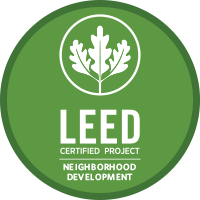As more and more shopping center developers jump on the environmental band wagon, it’s not as rare to see centers in varying formats built to Leadership in Energy and Environmental Design (LEED) standards – or even certified as such by the U.S. Green Building Council.
But LEED for Neighborhoods, first piloted by the U.S.G.B.C. in 2009 to promote principles of smart growth and new urbanism on a broader, neighborhood scale, isn’t as pervasive in the retail real estate world.
Columbus, Ohio-based Nationwide Realty Investors (NRI), the real estate development arm of Nationwide Mutual Insurance Co., is perhaps more familiar with LEED for Neighborhoods than most of its industry peers. The company has made it a practice to conceptualize and build large, walkable mixed-use projects, so taking the next step toward meeting LEED-ND requirements wasn’t a huge stretch. “Many of our existing projects exhibit the characteristics outlined on the LEED-ND scorecard,” said NRI president and COO Brian J. Ellis. “And becauseour development philosophy fits so well with the ideas behind LEED-ND, we knew that this would soon be an opportunity for us.”
When the LEED-ND program was announced, NRI was just beginning construction on Grandview Yard, a $500-million mixed-use project located on the reclaimed Big Bear Grocery warehouse site just outside of Columbus, Ohio. The project blends neighborhoods, retail districts, office and residential space, and connects them to the historic community of Grandview Heights, The Ohio State University and Columbus’ business districts, sports arenas and entertainment venues.
Phase one of the project, which opened fall 2010 includes a 92,000 sq. ft. silver LEED certified class A office building with ground floor retail and dining, a 126 room Hyatt Place Hotel, a 42,000-sq.-ft. fitness center and a 500-car parking deck. Under construction is a 154- unit apartment community, and a 92,000-sq.-ft. Giant Eagle supermarket is slated to open in late 2013.
When completed, Grandview Yard will comprise roughly 1.5 million sq. ft. of commercial space including retail, restaurants, and office and approximately 800 apartments and condominium-style residences. Most notably, however, is the fact that it will be the first development in the Midwest to become pre-certified as a LEEDND community.
“Many aspects of our master-planned project already met LEED-ND standards, so it was not difficult to embrace the new program,” said Ellis.
Some of the sustainable features of Grandview Yard include the redevelopment of the brownfield site, a high-density master plan; tree-lined and shaded streets; dedicated park and civic space; a pedestrian- and bicycle friendly circulation flow; and access to public transportation. All are hallmarks of a LEED-ND project, but perhaps the most significant is that, through rendering the U.S.G.B.C.’s vision of a sustainable community, NRI was able to create lifestyles with an eye toward the future.
“The exciting thing about LEED-ND is that it acknowledges the realities of complex communities,” said Ellis. “Because the buildings don’t have to be LEED-certified to realize the designation, developers can focus their attention and resources on LEED initiatives that effect the connectivity and sense of place in the environment.
“Creating a neighborhood isn’t about the construction of individual buildings. It’s about generating a vision that brings complementary elements together where the whole is far greater than the sum of its parts.”




